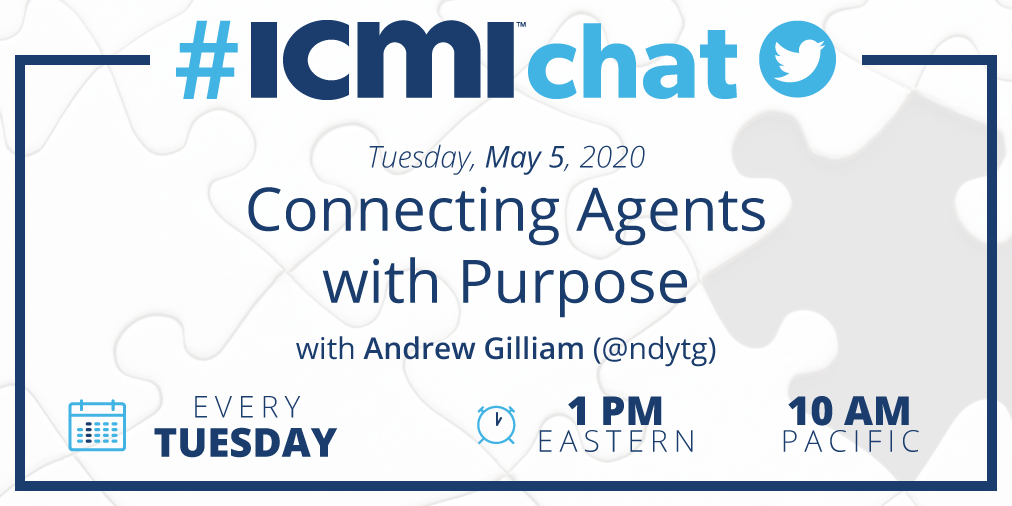By
The Editors
|
Date Published: April 29, 2020 - Last Updated September 08, 2020
|
Comments

Communication. Everyone does it, but few will call it a key strength of their organization. Communication often tops the charts of things employees would like to see improved within their company. Plenty of books have been written on the subject, but we wanted to find out what's working in the contact center.
Join us on Tuesdays at 1 p.m. Eastern, 10 a.m. Pacific to weigh in on the contact center industry's most pressing challenges. Next week, we explore "Connecting Agents with Purpose." A question preview follows this article.
It is particularly vital for remote teams, and it seems like everyone is getting a taste of work from home. In a social distancing world, verbal and written communication is an essential lifeline keeping teams together. We asked the #ICMIchat community about their communication strategies, and they did not disappoint.
Does Communication Impact Morale
In #ICMIchat, we uncovered the full spectrum of communication problems. On the one hand, overcommunicating can result in too many distractions, lost productivity, and essential messages getting lost in the noise. Conversely, communicating too little or not at all, makes employees feel left out or unimportant. We unanimously agreed that communication impacts the culture and morale of workplaces; the key is finding the right balance.
One of the biggest mistakes you can make with employee communication is thinking of employees as one object. They are separate human beings. Human beings experience communication in different ways depending on the situation.
Well, heck yes, communication efficacy and QUALITY affect employee engagement and morale. (See: Intranets that are content junk drawers, tone-deaf statements from the CEO, unreadable HR policies, etc.)
Definitely. In most cases the team probably thinks they don't have enough info and/or the right info, and the right time. We have to give thought to what/where/when/how we communicate.
Communication & Customer Experience (CX)
Consistently outstanding customer experiences require all parts of an organization to be on the same page. In this way, communication can make or break CX. Contact centers need to be informed of external events and changes that affect them, and other departments often get their customer understanding from the contact center. Even within the contact centers, communication is vital. With multiple channels, agent skills, and shifts, it's easy for customers to receive inconsistent service when communication falls short.
Agents need to speak in one voice. There is nothing more frustrating than calling a call center and receiving different information everytime you call.
Engaged Employees are what drive CX and ineffective modes of comms internally are going to adversely impact CX - e.g. inconsistent comms internally will result in inconsistent comms externally - it will confuse customers and reduce that trust they once had in you.
It's not a good look for a company's CX brand whereby agents are providing incorrect answers to customers' inquiries due to not receiving or reading the "latest internal communication update"
Not knowing the latest and greatest and being unprepared with the question/concern your customer has. Disjointed communication - I got an email that said XYZ, I called and your Agent said ABC, I hit social and they gave me the world.
Sharing Time-Sensitive Information
Constant change is the norm for most contact centers, and their ability to adapt and respond to the changing world and business around them is crucial. Great contact centers pivot instantaneously, while laggards risk sharing bad advice with customers. Contact center leaders' strategy for quickly disseminating knowledge to the front lines is no trivial matter.
Slack channel and follow up with an email. A team meeting is always preferable but is not always timely and I would still follow up with an email to be referenced by the team.
Ping > Personal Email > Distribution List Email > Mass Announcements. Over time, employees will learn to tune out a frequency if it's being abused. Use them wisely! Tools like Slack/MS Teams make it easy to broadcast pings but use them well.
I like Knowledge Management systems for this. They provide an ongoing reference point and you can see if someone read it. If not a KM system then any system that can push out a notification that the sender can verify it has been read and understood is great.
Selecting the Right Medium
When convened in person, contact center leaders have a plethora of options when it comes to sharing information. Choosing the right medium for the message can be tricky. Should the latest announcement go out in one-to-one meetings with floor supervisors, or is it worth convening the entire center for an all-hands meeting? Is posting a note in the agent chat room good enough, or is email more effective? These choices affect how messages will be received by agents and the speed at which new information is acted on.
Categorise them into one-way or two-way communication. If it's going to be one way, rate them on impact and urgency and choose from all hands to mass email. If it's going to be two way, weigh the audience, rate the impact and urgency, choose from chat to in-person.
This is probably important to systematize a bit. When I was leading, it was always a conversation with my sups first and we decide the best way to share important information.
I decide what my perfect outcome would be. Who needs to know, how soon do they need to know etc. I try to keep it to the relevant teams otherwise it creates too much noise!
Getting Together
Some messages are meant to be broadcast, yet some are intended to be personalized. A downfall of mass communications is the inability of agents to ask questions about news that affects their work. Meeting one-on-one with managers or in small teams is indispensable, no matter how skilled you are at posting on the company intranet.
Adopting from the development folks, I love a good daily stand up with leadership if at all possible. As long as we focus on actual business and not just social hour.
I'd go with a daily check in of 5 minutes worth each of my directs. Weekly 1-1 of 15 minutes. Monthly all hands of 45 mins. Emergency meetings anytime. Friendly banter, all the time!
Routine 1:1 with standard agenda - at least monthly. I meet with my team weekly. Depends on team size and needs of the team. Ad hoc meetings need to happen for feedback as opportunities or challenges arise. Lastly, interact CONSTANTLY. Chat, phone, etc. Stay in touch!
I love the new AI tools that identify the employee's optimal learning style based on data. Managers can use the AI learning profile to identify communications methods, tools, schedules, and training requirements to personalize the employee's experience.
Regular meetings with direct reports are times for teaching, mentoring, even venting. They should be done according job demands: daily during new projects/stressful times; weekly when things are running smoothly; monthly when a worker is proficient and things going well.
Capturing Their Attention
No practice has been more upended by technology than communication. Technological advances have offered us more ways to reach our employees than ever before. At the same time, some argue that new communication mediums have shortened our attention spans. Not to mention, with so many employees working remotely, it's not as easy to converse in person as it has been in the past. Is it time for contact centers to catch up and make announcements using multimedia?
All good ideas but I hope we don't get lost in the activity. For example, using 'quality' as an excuse to delay an internal podcast/video is not ideal. Remember, the goal is not to impress the audience - the goal is to ensure the message reaches the employees.
Our executive leadership team is doing periodic videos on topics of importance as well as responding to questions that are submitted in advance. These have been well received!
I've been using video to collaborate on #CXQOTD but that's more been about connecting with our CX community in a meaningful way when we're all apart.
Executive Outreach
Employee perceptions of fairness and understanding are critical components of positive organizational cultures. Agents want to know that senior leaders care about them, understand their needs, and shape strategies with everyone's interest in mind. #ICMIchat seems to agree that it's essential that even senior leadership connect with front-line employees on some level while being cautious not to overstep first-level managers.
Building rapport w/indirect reports and front-line agents is a proven way to increase engagement. Gamification is a great way to achieve this. C-level execs, directors, managers, supervisors, and agents all benefit from playing to win on the same team!
Absolutely. Spend time with them. Shadow your front line staff, have "office hours" present at meetings topics they care about, LISTEN when they give feedback and close the loop regardless of the outcome. "Manage by walking around" - be visible and available.
Oh yes! Your direct reports aren't always incentivised to tell you the truth. Your indirect ones are! As senior leaders, if you REAAAALLLLY want to know what's happening, go on gemba walks. Just walk around the floor and talk to people at random.
Yes, but it needs to be higher level. One thing I had experience in the past is when the executive gets too deep with indirect reports and thus circumvents the manager in between. This can result is a lack of communication between direct managers.
Messages From the Top
There are times where messages must be distributed quickly through an organization, from executives to every employee. There are different approaches to this type of communication, being passed down through middle management or connecting directly with employees. There are pros and cons to each method, and the best choice depends on what needs to be communicated.
I believe in direct communication, using plain language (Leslie O'Flahavan, thanks!) I do not let my title stop me from communication with an agent or the CEO. Too much time is wasted and lots of room for misinterpretation.
Who has played the game of telephone? I'd argue that chains can be risky depending on how important the information is.
Messages that can evoke strong emotions immediately, direct is best. You can address them on the spot. Process, policy and dept level org changes etc can go through chain of command.
When it's about behaviour and culture. Everyone owns that and has the right to call out bad behaviour or language that degrades a culture. Chain of command comes into it when it's commercial, procedural and political or... when there is no psychological safety.
The quality of internal and external communication can make or break your contact center. With these tips, we can all build strong cultures of connectedness, respect, and productivity. Chime in on your contact center challenges in our next #ICMIchat!
#ICMIchat May 5, 2020
Connecting Agents with Purpose

Q1: Can every company achieve a relatable mission and purpose, or is this reserved for only an altruistic few?
Q2: Does a sense of mission and purpose impact employees’ work quality and productivity?
Q3: How can leaders help employees find purpose and connect with the mission?
Q4: How does connectedness with the company’s mission influence employee retention?
Q5: Do/should you hire for purpose or alignment with the mission? What role does/should this play in the recruitment and selection process?
Q6: Is it wise to keep employees informed about how individual contributions impact the company’s financial health, or does this add undue stress?
Q7: How often should leaders reinforce the company’s mission and values? What’s your preferred strategy?
Q8: Is senior leadership important to instilling a sense of mission and purpose within a team? How should they pitch in?